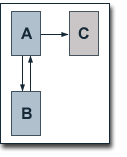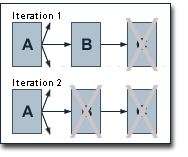We regard a web consisting of to websites, each having two web pages. One site consists of pages A and B, the other constists of pages C and D. Initially, both pages of each site solely link to each other. It is obvious that each page then has a PageRank of one. Now we add a link which points from page A to page C. At a damping factor of 0.75, we therefore get the following equations for the single pages' PageRank values:
PR(A) = 0.25 + 0.75 PR(B)
PR(B) = 0.25 + 0.375 PR(A)
PR(C) = 0.25 + 0.75 PR(D) + 0.375 PR(A)
PR(D) = 0.25 + 0.75 PR(C)
Solving the equations gives us the following PageRank values for the first site:
PR(A) = 14/23
PR(B) = 11/23
We therefore get an accumulated PageRank of 25/23 for the first site. The PageRank values of the second site are given by
PR(C) = 35/23
PR(D) = 32/23
So, the accumulated PageRank of the second site is 67/23. The total PageRank for both sites is 92/23 = 4. Hence, adding a link has no effect on the total PageRank of the web. Additionally, the PageRank benefit for one site equals the PageRank loss of the other.
The Actual Effect of Outbound Links
As it has already been shown, the PageRank benefit for a closed system of web pages by an additional inbound link is given by
(d / (1-d)) × (PR(X) / C(X)),
where X is the linking page, PR(X) is its PageRank and C(X) is the number of its outbound links. Hence, this value also represents the PageRank loss of a formerly closed system of web pages, when a page X within this system of pages now points by a link to an external page.
The validity of the above formula requires that the page which receives the link from the formerly closed system of pages does not link back to that system, since it otherwise gains back some of the lost PageRank. Of course, this effect may also occur when not the page that receives the link from the formerly closed system of pages links back directly, but another page which has an inbound link from that page. Indeed, this effect may be disregarded because of the damping factor, if there are enough other web pages in-between the link-recursion. The validity of the formula also requires that the linking site has no other external outbound links. If it has other external outbound links, the loss of PageRank of the regarded site diminishes and the pages already receiving a link from that page lose PageRank accordingly.
Even if the actual PageRank values for the pages of an existing web site were known, it would not be possible to calculate to which extend an added outbound link diminishes the PageRank loss of the site, since the above presented formula regards the status after adding the link.
Intuitive Justification of the Effect of Outbound Links
The intuitive justification for the loss of PageRank by an additional external outbound link according to the Random Surfer Modell is that by adding an external outbound link to one page the surfer will less likely follow an internal link on that page. So, the probability for the surfer reaching other pages within a site diminishes. If those other pages of the site have links back to the page to which the external outbound link has been added, also this page's PageRank will deplete.
We can conclude that external outbound links diminish the totalized PageRank of a site and probably also the PageRank of each single page of a site. But, since links between web sites are the fundament of PageRank and indespensable for its functioning, there is the possibility that outbound links have positive effects within other parts of Google's ranking criteria. Lastly, relevant outbound links do constitute the quality of a web page and a webmaster who points to other pages integrates their content in some way into his own site.
Dangling Links
An important aspect of outbound links is the lack of them on web pages. When a web page has no outbound links, its PageRank cannot be distributed to other pages. Lawrence Page and Sergey Brin characterise links to those pages as dangling links.

The effect of dangling links shall be illustrated by a small example website. We take a look at a site consisting of three pages A, B and C. In our example, the pages A and B link to each other. Additionally, page A links to page C. Page C itself has no outbound links to other pages. At a damping factor of 0.75, we get the following equations for the single pages' PageRank values:
PR(A) = 0.25 + 0.75 PR(B)
PR(B) = 0.25 + 0.375 PR(A)
PR(C) = 0.25 + 0.375 PR(A)
Solving the equations gives us the following PageRank values:
PR(A) = 14/23
PR(B) = 11/23
PR(C) = 11/23
So, the accumulated PageRank of all three pages is 36/23 which is just over half the value that we could have expected if page A had links to one of the other pages. According to Page and Brin, the number of dangling links in Google's index is fairly high. A reason therefore is that many linked pages are not indexed by Google, for example because indexing is disallowed by a robots.txt file. Additionally, Google meanwhile indexes several file types and not HTML only. PDF or Word files do not really have outbound links and, hence, dangling links could have major impacts on PageRank.

In order to prevent PageRank from the negative effects of dangling links, pages wihout outbound links have to be removed from the database until the PageRank values are computed. According to Page and Brin, the number of outbound links on pages with dangling links is thereby normalised. As shown in our illustration, removing one page can cause new dangling links and, hence, removing pages has to be an iterative process. After the PageRank calculation is finished, PageRank can be assigned to the formerly removed pages based on the PageRank algorithm. Therefore, as many iterations are needed as for removing the pages. Regarding our illustration, page C could be processed before page B. At that point, page B has no PageRank yet and, so, page C will not receive any either. Then, page B receives PageRank from page A and during the second iteration, also page C gets its PageRank.
Regarding our example website for dangling links, removing page C from the database results in page A and B each having a PageRank of 1. After the calculations, page C is assigned a PageRank of 0.25 + 0.375 PR(A) = 0.625. So, the accumulated PageRank does not equal the number of pages, but at least all pages which have outbound links are not harmed from the danging links problem.
By removing dangling links from the database, they do not have any negative effects on the PageRank of the rest of the web. Since PDF files are dangling links, links to PDF files do not diminish the PageRank of the linking page or site. So, PDF files can be a good means of search engine optimization for Google.